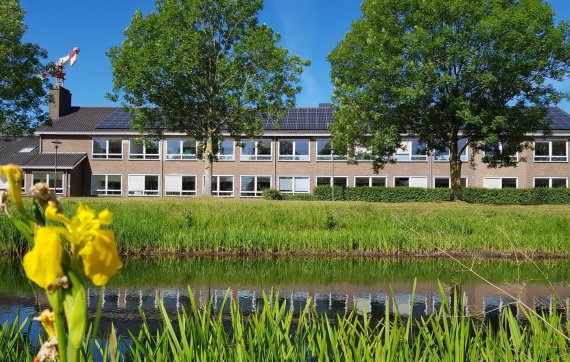The video screens in the hall of Zodiac will soon be showing how much energy has been generated on the roof, where 600 solar panels on the roof have been converting light into electricity for a week now. Adding Zodiac to the considerable list of WUR roofs with solar panels.
Great strides
Solar panels were installed on the roof of the second sports hall at De Bongerd sports centre four years ago. That was WUR’s first big project, with a total of 459 panels. Another big step was taken two years ago, when 1340 solar panels were placed on part of the roofs of Radix Klima and Agros. A further 1300 have been added recently, says energy coordinator Michiel van der Wal.
If all goes to plan, it will be the turn of the barns at Carus livestock research facility this summer. Van der Wal: ‘The tender process is ongoing now. We got a subsidy for 2000 panels.’ This subsidy comes from Stimulation of Sustainable Energy Production (SDE+), a fund for compensating producers of renewable energy. That compensation is crucial to the installation of solar panels.
This subsidy on the energy that is produced makes for a relatively short payback time for the solar panels. ‘About 10 years,’ says Van der Wal. ‘But that subsidy, specifically for solar panels on roofs, has quickly become smaller. That makes the payback time longer and makes investing in solar panels less attractive.’ The last round of subsidies was also very oversubscribed.
By the wayside
So some WUR initiatives fell by the wayside, with applications for subsidies for panels on Gaia, the ESG building and Axis being turned down. WUR projects in Lelystad did win some funding, however. Accres already boasts 3000 solar panels, and 1500 were placed on the roofs of Bioveterinary Research this month. And there are plans for a further 3000 panels, reports Van der Wal.
Smaller numbers of panels have been installed here and there as well. Between them, all these panels generate a lot of electricity. ‘Based on a possible 12,000 panels on WUR roofs, each producing 250 kWh, you end up with three million kWh per year,’ Van der Wal calculates. Enough to supply 1000 average households with electricity. Given the scale of WUR, however, that is a limited contribution: ‘Only about five per cent of the electricity we consume in a year.’

 Solar panels on the roof of Zodiac. Photo: Roelof Kleis
Solar panels on the roof of Zodiac. Photo: Roelof Kleis